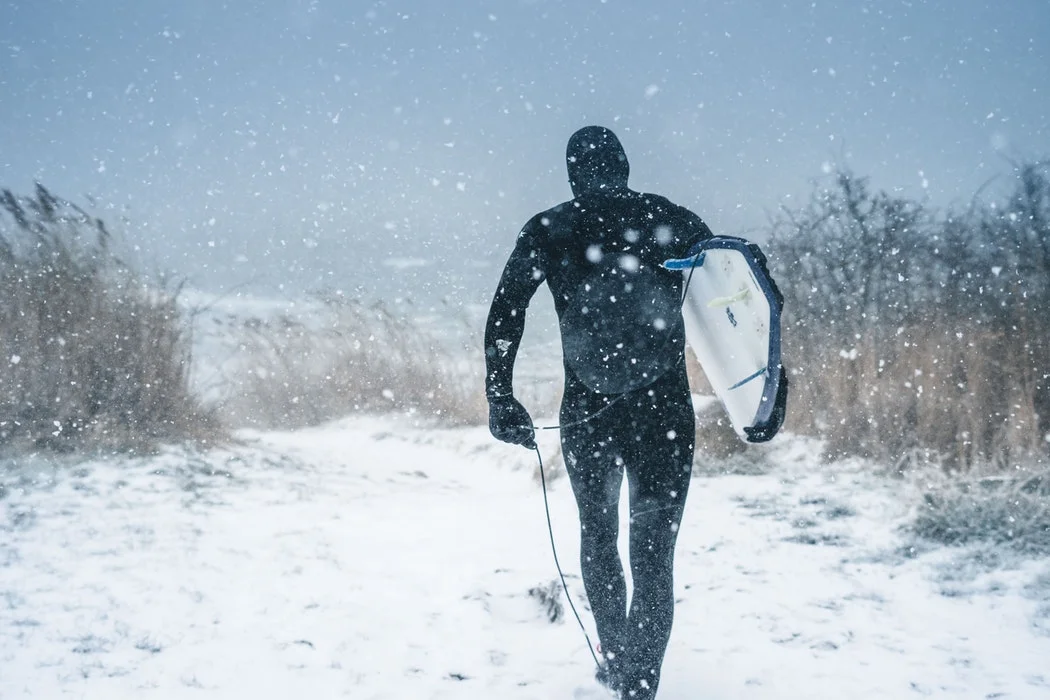Wetsuits act as a layer of skin keeping the body heat between you and the wetsuit while allowing a thin layer of water to enter so the body heat warms up the water and this further helps to keep you warm.
Whilst wetsuits are designed to stop you from feeling the cold, they still need to be flexible enough so the surfer can move around comfortably. Technological advances in wetsuit materials and design centre on surfers staying warm in all sorts of weather conditions and having maximum flexibility.
Design
Wetsuits are designed to cover the body. The more body coverage, the warmer you will be in the water. There most popular designs are:
Steamer (or full suit) is used in cold water conditions to extreme cold water conditions.
Spring suit (or three quarter length) is generally used in cool to mild temperatures.
Vests are for mild to warm temperatures. This is when the water may be warm, but the strong winds can still be quite cold.
You can also get variations on the above including:
Steamer with short arms and long legs
Steamer with no arms and long legs AKA the long john
Steamer with short legs and no arms AKA the short john
Wetsuits, with long legs also typically have knee pads to help protect your knees rubbing against the hard surface of the board and to protect your board from bangs and knocks from your knees.
Wetsuits are made up of panels of a flexible rubber material called neoprene which are stitched together. Neoprene allows the wetsuit to stretch and fit close to your body. The more panels in a wetsuit, the more flexible it will be.
The wetsuit can also have more stretchy material in places that need more flexibility such as the arm, underarm, shoulder panels and lower back especially when paddling and for easier turning.
Wetsuits are generally black in colour. That’s because the black absorbs heat from the sun more than other colours.
Lining
Wetsuits also have a lining on the inside which further helps retain your body heat. This is called “single line neoprene” and is referred to as a “smoothie” wetsuit. This is because the outside neoprene is smooth rubber. They can also have a lining on the outside called “double lined neoprene”. This extra lining helps protect the wetsuit making it last longer.
Double lined neoprene wetsuits have a material-like look. However, “double lined neoprene” is slightly less flexible and less warm than the “single lined neoprene” wetsuit.
Lining material is typically made of nylon. Recent advances in wetsuit lining materials include linings made from:
Polypropylene — repels water and helps keep you more dry.
Titanium oxide — reflects heat that is radiated from the body. It is generally applied between the neoprene and nylon lining.
Some wetsuits also have extra inserts which provide even more warmth without providing much more thickness.
Seams
The seams are in places where water is able to penetrate the wetsuit. When you are moving about in the surf, cold water will be flowing into the wetsuit. The amount of water flowing into, and out of the wetsuit will determine how warm you will be. That is, how effectively your body can heat up the layer of water that gets into the wetsuit.
The less water that enters and exists the suit, the warmer you will be. The seams of the wetsuit can be sealed in different ways including:
Overlock — the least expensive type of stitching. Not watertight. It sticks out and can cause rash.
Flatlock — flatter stitch than overlock so will not cause as much rash (if any). Not watertight. Not as durable as overlock stitch.
Blind stitch — a flat stitch meaning little rash problems. Stitch does not go through the neoprene. This means there are less holes to let in water. Can also have double blindstitch where the stitching is on both sides. This means There are no holes at all in the neoprene. Less durable than flatlock and overlock stitch.
Glued — applied to blindstitch and double blindstitch seams. The glue helps to seal the seams.
Protective tape — applied to blindstitch and double blindstitch seams with glue the tape is applied on the inside seams and provides more smoothness and added sealing. These wetsuits are watertight allowing warm water near the body to stay close to your skin instead of flowing out of the suit as you move in the water. Some wetsuits may have the tape applied on some seams only meaning more water will flow into and out of the suit than a fully sealed suit.
Liquid seal — tape that is rubber welded. This type of seal sits much flatter than protective tape and is very watertight.
The neck area of wetsuits generally have an adjustable Velcro fasting. As necks are different sizes, you are able to fasten the Velcro to suit your neck size to fit tightly but not too tight.
Water can also enter through the zip of the wetsuit. Zips come in different qualities from plastic (not so durable) to metal zippers (more durable). Flaps of neoprene (or other material) behind the zip are often in place to help prevent water entering. There can also be larger pieces of material fixed across the back and covering the whole zip area. These are quite effective in reducing water inflow. New advances in wetsuit design have seen zips placed in the shoulder and zipper free wetsuits have also been designed.
Thickness
The thickness of the wetsuit material (neoprene) may vary depending on the temperature of the water. The thicker the wetsuit material, the warmer it will be. However, the wetsuit will not be as flexible.
There are different thicknesses for different parts of the body. The torso of the wetsuit is usually thicker as it is the part that is most exposed to the cool winds. The arms, legs and joints are usually less thick to ensure maximum flexibility.
Wetsuit thicknesses are measured in millimetres. When describing wetsuit thickness, two measurements are usually given. For example, the wetsuit may be described as a 3/2. The first number (usually the largest) is the body torso (back and chest) thickness. The second number (usually the smaller figure) is the arm, leg and joints thickness.
Standard wetsuit thicknesses are:
5/4 — very cold water
4/3 — cold water
3/2 — cool water
Wearing a Wetsuit
Make sure the wetsuit fits tightly but not so tightly that it is uncomfortable. If it’s too loose, extra water will stay trapped in the wetsuit making it much heavier.
When you buy a new wetsuit, it can be a little bit tighter, but it will loosen up a little after you get out in the water a few times.
Getting into a steamer (full suit) can be difficult at the best of times. You can put a plastic bag around your feet and hands and then pull it on for an easier transition.
Wetsuit Care and Maintenance
As the wetsuit gets older, the neoprene deteriorates. Cracks and tears can develop and the neoprene can stiffen. Seams can also become worn and open.
You can look after your wetsuit by:
Washing it in fresh water after use
Do not put in a spin dryer / washing machine
Do not iron
Do not leave near the heater/fire or on heaters
Do not leave in direct sunlight to dry
The post important care part is how you hang it. Never hang your wetsuit like you would a shirt — don’t place the hanger through the shoulders, fold it over the base instead.
For more wetsuit care instructions read our previous blog post here.


















